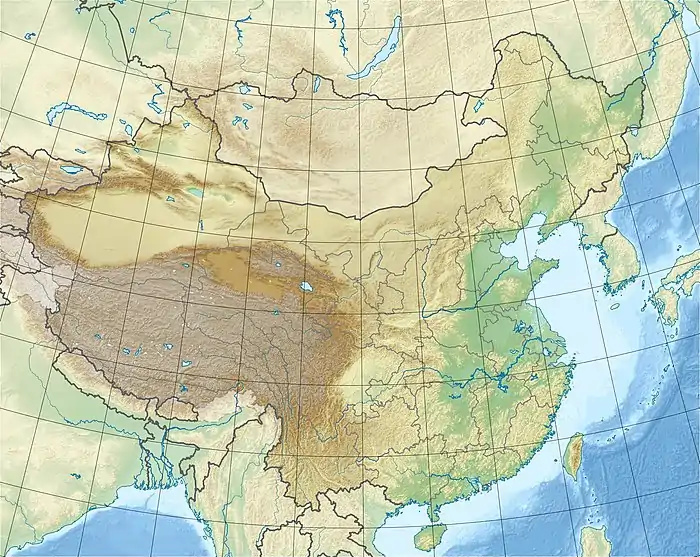Sima Jinlong
Sima Jinlong (Chinese: 司馬金龍; after 420-484), courtesy name Rongze (榮則), was a Han–Xianbei prince and general of the Xianbei-led Northern Wei dynasty of China, whose tomb was discovered in the village of Shijia, Datong, Shanxi.[2]
| Sima Jinlong 司馬金龍 | |
|---|---|
.jpg.webp) Army of terracotta figurines in Xianbei uniform, tomb of Sima Jinlong.[1] | |
| Created | 484 CE |
| Discovered | Datong, Shanxi province. |
 Datong | |
Sima Jinlong was of mixed Han and Xianbei heritage: he was the son of the Eastern Jin prince Sima Chuzhi (司馬楚之), who had become a refugee at the court of the Northern Wei dynasty when the Eastern Jin dynasty collapsed in 420, and his mother was a Northern Wei princess.[3] After 420, Sima Chuzhi served as a general in the northern Wei army until his death when he was buried in the imperial tomb enclosure.[4] Sima Jinlong spent his whole life among the Northern Wei, and married the daughter of the Northern Liang ruler Juqu Mujian.[3] His son Sima Huilang lived among the Wei with full honors, as an officer in the army, but his actual role seems to have been minor compared to his father, as he his only mentioned briefly after his father in official chronicles, such as the Book of Wei (37)[5] Bei Shi (29).[6][4]
His tomb, of an impressive size, is dated to 484 CE and was found in the Northern Wei capital.[4][7] The bodies of the deceased had been placed on an elaborately carved stone couch.[8] Many terra-cotta funerary figures were found in the tomb, which are characteristic of the Northern Wei.[9] They represent the progressive absorption of Han influences into the artistic productions of the Xianbei people under the rule of the Tuoba imperial clan.[9]
.jpg.webp) Xianbei female attendant, probably a musician. Tomb of Sima Jinlong, 484 CE.[10]
Xianbei female attendant, probably a musician. Tomb of Sima Jinlong, 484 CE.[10].jpg.webp) Northern Wei Pottery Figure, Tomb of Sima Jinlong, 484 CE
Northern Wei Pottery Figure, Tomb of Sima Jinlong, 484 CE Lacquer screen, from the tomb of Sima Jinlong, 484 CE. Probably brought from the court of the southern Jin dynasty by Jinlong's father.[11][12]
Lacquer screen, from the tomb of Sima Jinlong, 484 CE. Probably brought from the court of the southern Jin dynasty by Jinlong's father.[11][12] Tomb plaque of Sima Jinlong.
Tomb plaque of Sima Jinlong.%252C_detail.jpg.webp) Elaborately carved stone funerary bed of Sima Jinlong, 484 CE.[8]
Elaborately carved stone funerary bed of Sima Jinlong, 484 CE.[8].jpg.webp) Carved stone column base, Tomb of Sima Jinlong.[13]
Carved stone column base, Tomb of Sima Jinlong.[13]
See also
- Description of the panels (Chinese): 彩绘人物故事漆屏
References
- Dien, Albert E. (1 January 2007). Six Dynasties Civilization. Yale University Press. ISBN 978-0-300-07404-8.
- 汉唐之间文化互動與交融国际学术研讨会论文汇编. 北京大学. 2000. p. 263.
Grave goods in the three post-Han centuries in Gansu in China, sites on Ningxia, Shaanxi, Shanxi and Hebei, seem to be more lavish than those to Gansu's west, but the architecture of those tombs is not more complicated. Some of the objects and many of the wall paintings found in these tombs are extraordinary, and therefore are extremely well-known. All are tombs of non - Chinese occupants identified as Xianbei : the accidental find at Guyuan in which the lacquered coffin and coin of Sasanian ruler Firûz I was found ; the Guyuan tomb of Li Xian (d . 569) in which the Sasanian ewer was excavated; the tombs of Sima Jinlong (d. 484) and Empress Dowager Wen Ming (d. 483) in Datong; the tomb of the so-called Ruru princess in Ci county, Hebei ; the tombs of Kudi Huiluo in Shouyang, and the tombs of Zhang Susu (d . 562), and Lou Rui (d . 570) near Jinyang in central Shanxi
- China: Dawn of a Golden Age, 200–750 AD. Metropolitan Museum of Art. 2004. pp. 18–. ISBN 978-1-58839-126-1.
sima.
- Karetzky, Patricia Eichenbaum; Soper, Alexander C. (1991). "A Northern Wei Painted Coffin". Artibus Asiae. 51 (1/2): 9. doi:10.2307/3249674. ISSN 0004-3648. JSTOR 3249674.
- Weishu, Book 37.
金龍初納太尉、隴西王源賀女,生子延宗,次纂,次悅。後娶沮渠氏,生徽亮,即河西王沮渠牧犍女,世祖妹武威公主所生也。有寵於文明太后,故以徽亮襲。例降為公。坐連穆泰罪失爵。
- Wei Shi, Book 29.
金龍初納太尉、隴西王源賀女。生子延宗,次纂,次悅。後娶沮渠氏,生子徽亮,即河西王沮渠牧犍女,太武妹武威公主所生也。有寵于文明太后,故以徽亮襲。例降為公,坐連穆泰罪,失爵,卒。
- Dien, Albert E. (1 January 2007). Six Dynasties Civilization. Yale University Press. pp. 91–92. ISBN 978-0-300-07404-8.
- Dien, Albert E. (1 January 2007). Six Dynasties Civilization. Yale University Press. p. 203. ISBN 978-0-300-07404-8.
- Howard, Angela Falco; Hung, Wu; Song, Li; Hong, Yang (1 January 2006). Chinese Sculpture. Yale University Press. p. 113. ISBN 978-0-300-10065-5.
- Watt, James C. Y. (2004). China: Dawn of a Golden Age, 200-750 AD. Metropolitan Museum of Art. p. 161. ISBN 978-1-58839-126-1.
- Dien, Albert E. (1 January 2007). Six Dynasties Civilization. Yale University Press. pp. 295–296. ISBN 978-0-300-07404-8.
- Watt, James C. Y. (2004). China: Dawn of a Golden Age, 200-750 AD. Metropolitan Museum of Art. pp. 158–160. ISBN 978-1-58839-126-1.
- Watt, James C. Y. (2004). China: Dawn of a Golden Age, 200-750 AD. Metropolitan Museum of Art. p. 162. ISBN 978-1-58839-126-1.